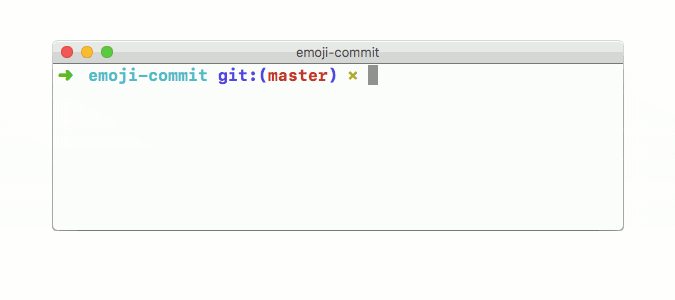11 releases
| 0.1.10 | Oct 12, 2022 |
|---|---|
| 0.1.9 | Oct 11, 2022 |
| 0.1.8 | Aug 4, 2021 |
| 0.1.7 | Jun 9, 2021 |
| 0.1.2 | Nov 13, 2016 |
#3 in #committer
41 downloads per month
22KB
386 lines
Emoji Commit
Make your git logs beautiful and readable with the help of emojis 🎉
The idea with the emoji committer is to tag each of your commit with an emoji that corresponds to a bump in semver. This information can the be used to automatically publish new versions, generate a change log and make the git log give you a quicker glance over whats been happening.

Table of contents
Installation
cargo install emoji-commit
Usage
The emoji committer can be used in two ways. Either invoked directly, or by configuring git to invoke it.
Invoke directly
Simply call emoji-commit as you would any other command:
emoji-commit
Configure Git
You can set the core.editor configuration in git the the emoji committer to always use it when committing.
git config --global core.editor 'emoji-commit'
The emojis
The following emojis where chosen for the emoji committer:
| Emoji | Name | Semver | Meaning |
|---|---|---|---|
| 💥 | Collision | major | Breaking change |
| 🎉 | Party popper | minor | New feature |
| 🐛 | Bug | patch | Bugfix |
| 🔥 | Fire | patch | Cleanup / Performance |
| 🌹 | Rose | Meta |
💥 Breaking change
Use this commit type if your change is in any way breaking to the intended consumer. Keep in mind that "breaking" has different meaning in different contexts, e.g. adding a field to a struct is a breaking change in Rust, but is generally considered a backwards compatible change in Node.js.
🎉 New feature
Use this commit type if you have added a new feature in a fully backwards compatible way. Keep in mind that adding documentation for a previous undocumented feature can qualify under this type, since undocumented APIs aren't a part of the public API.
🐛 Bugfix
Use this commit type if you have fixed a bug. The rationale for having two "patch" types is to be able to quickly get a list of all the bugs that have been fixed.
🔥 Cleanup / Performance
Use this commit if your change will impact the consumer in some way, be it a documentation change, optimizing an if-statement or simply removing some unnecessary semicolons.
🌹 Meta
Use this commit when you change won't have any impact on the consumer. This does not include changes to the code that still should have it "behave the same" since those changes should result in a new build being published.
A common use case for this emoji is editing your .travis.yml file to change something with the build, or adding some more tests.
The version bump
Many publishing tools, e.g. npm, have a step where you'll bump the version in some file, committing that, and then publish everything to a registry. For this specific use case we have introduced a special emoji.
🚢 Release
Use this commit type when cutting a new release. Commits with this emoji should preferably be made automatically by some sort of continues delivery system, which also publishes the package.
I hope to release some tools for making this easier in the near future. In the mean time, you can use this handy shortcut for npm:
npm version <bump> -m '🚢 %s'
Troubleshooting
git log doesn't show emojis on macOS
macOS ships with a very outdated less that doesn't support showing emojis out-of-the box. Read more in this blogpost for a proper solution, or run the following command to make it work™.
git config --global core.pager 'less -r'
Dependencies
~13MB
~283K SLoC